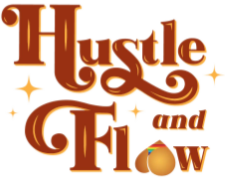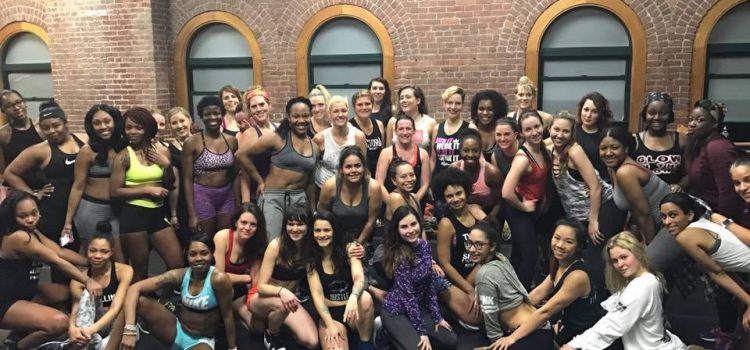Boss Chick Portia Singh is returning to Hustle and Flow for her Twerkshop next month! I’m telling you about it now because the last one sold out fast, and you definitely want to be there this time around. You can sign up right now, but first – let’s talk twerking!
When did you first hear about twerking? For me, it was Miley Cyrus’ 2013 MTV VMA performance, infamous for her awkward, off-putting act with Robin Thicke (whose single “Blurred Lines” had already drawn controversy for being pro-sexual assault) and her showcasing of this new-to-most-people dance move called twerking.
All in all, a pretty strange way for Miley to honor a dance move that, in fact, has joyful, generations-old West African roots and in the US has deep cultural connections to people of color and the LGBT+ community.
Though you can find twerking and variations thereof throughout the world in communities with populations high in people of African descent, here in the States the dance is most closely connected with the New Orleans Bounce Music scene, particularly after hurricane Katrina. Bounce is a style of hip hop that originated in New Orleans in the late 80’s with artists like DJ Jimi and Juvenile. These days, Big Freedia is the reigning Queen of Bounce – even if you don’t know her, you’ve probably heard her single “Booty Whop” at a party at some point.
 One of the neat things about Bounce is that it makes room for all kinds of people, particularly those in marginalized communities, including people of color, women, non-binary and non-cisgendered people, queer people, gay people and outsiders of all stripes. And when it comes to twerking, the same communities embrace the dance as their own, an expression of their cultural experiences.
One of the neat things about Bounce is that it makes room for all kinds of people, particularly those in marginalized communities, including people of color, women, non-binary and non-cisgendered people, queer people, gay people and outsiders of all stripes. And when it comes to twerking, the same communities embrace the dance as their own, an expression of their cultural experiences.
But twerking is still a dance, and dancing is a happy, social experience, meant to be shared and enjoyed by everyone! So why was Miley’s performance considered offensive and culturally appropriative? And what can we do to honor the legacy and rich meaning of a dance if we’re not a part of the community from which it originated?
Imitation is not inherently negative or insulting. In general, imitation is a necessary part of our development as children and adults. It’s a form of social learning that ultimately forms our culture at large. I often think of imitation as a form of flattery. But while it might be fine to buy the same shoes your best friend has without a second thought, we have to enter into cultural imitation with humility, forethought and gratitude.
Miley’s twerking performance short shrifted twerking in a couple of ways, ways that are easy to avoid as we embark on Portia’s Twerkshop. I love Miley’s work ethic and gusto, but the dance performance itself was a poor facsimile of a real twerking performance, as if being associated with knowing about the dance was enough, her “cool kid” card. She spared no expense for the world’s best choreographers, but she hadn’t cut her teeth in a New Orleans social aid club. If that performance had happened in 1995, we might have called Miley a “poser.” A simulacrum of the real deal.
When we approach a dance like twerking, we have to be open to the fact that it might be very new to us, and we might be very, very bad at it. That’s ok! When adversity shows up, along with it appears a temptation to change things, to take shortcuts. That does a disservice to ourselves and to the dance we wish to learn and honor.
So surrender to the experience of learning. Let’s just know that we don’t know, that we’re not perfect and that learning takes time. Give yourself over to the dance and simply engage and do your best. Twerking is HARD, it’s athletic and it’s really, really fun to do it badly. Trust me, I’ve been doing it really badly for about two years now.
But the more upsetting part of Miley’s performance was the hypersexualization of twerking and the fetishizing and exploitation of black women’s bodies during the performance. It’s almost as if she peeled off only one aspect of twerking – sexuality – and focused solely on that rather than going deeper into the move and fully embodying it as a dance move of power, defiance, self-confidence, self-expression, joy and, yes, sexuality.
Like many club dances that are associated with marginalized groups often are in US mainstream culture, twerking is wrongly stigmatized as being an indicator of deviant behavior – a modality with which to further push these groups to society’s fringes and deny them economic privileges. By focusing on the sexual aspects of twerking alone, Miley didn’t help the culture she borrowed from – she harmed it further while using it to her advantage.
She also probably made a lot of money off of a dance move created by people resisting and reacting to their experiences of oppression, including economic oppression.
 I doubt any of us will ever attempt to make a cool mil off of twerking, but we owe it to ourselves and our sense of solidarity to learn the dance’s origin story, what it means to the people who created it, and understand the whole of the dance’s cultural associations and not just the parts of it that suit our needs. This is one way to honor the culture, but it’s also a great way to go deeper into the dance, to embody the dance’s beautiful meaning and learn more than just how to shake our booties, though we’ll learn that too!
I doubt any of us will ever attempt to make a cool mil off of twerking, but we owe it to ourselves and our sense of solidarity to learn the dance’s origin story, what it means to the people who created it, and understand the whole of the dance’s cultural associations and not just the parts of it that suit our needs. This is one way to honor the culture, but it’s also a great way to go deeper into the dance, to embody the dance’s beautiful meaning and learn more than just how to shake our booties, though we’ll learn that too!
Let’s get together and twerk in joy and love and get a killer workout at the same time! Sign up for Portia’s Twerkshop on December 2nd now to make sure you reserve your spot! This workshop WILL sell out! Women and female-identified only, and no experience necessary!
We’ll see you there, but in the meantime, check out this awesome video of Big Freedia – in like the most chill way ever, of course – teaching people how to bounce, and pick up some sweet moves in advance:

